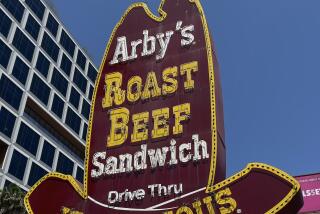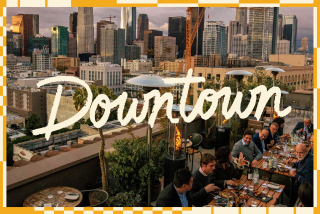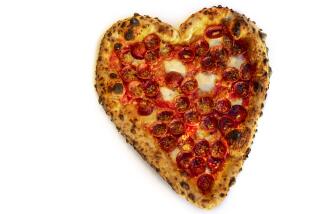A valentine gift for See’s?
Sweet. Los Angeles officials are taking steps to commemorate the city’s confectionery culture, just in time for Valentine’s Day.
Members of the Cultural Heritage Commission agreed Thursday to consider designating the original home of See’s Candies, near Western Avenue and Beverly Boulevard, as a historic landmark.
Nomination papers calling for recognition of the first See’s candy kitchen and retail shop were filed at City Hall in an empty 5-pound See’s box by candy lover Charlene Nichols.
The 43-year-old Altadena resident showed up for Thursday’s hearing carrying smaller boxes of See’s for commissioners. They politely turned down the samples of milk almond, vanilla buttercream and maple walnut candies on ethical grounds, however.
But they savored the history of Charles Alexander See’s candy factory like a milk chocolate cordial.
Nichols explained that the candy kitchen and chocolate store opened in 1921 at 135 N. Western Ave. See used chocolate recipes handed down by his mother, Mary.
The two-story Italian Renaissance revival-style building was painted in what would become See’s signature sparkling white. The shop was decorated with the same tile flooring and Art Deco hanging lamps that the company’s 210 stores use today.
Tapping into the growing L.A. love for the automobile, See employed couriers riding sidecar-equipped Indian motorcycles decorated with miniature replicas of the shop with the black-and-white See’s logo to deliver chocolate around town.
By the next year See’s had four more shops. By 1931 the candy maker had 25 stores and was outgrowing the original kitchen. A larger factory was opened near USC.
Nichols, who is an archivist at the Jet Propulsion Laboratory, said she developed her own See’s sweet tooth when she was a child.
“By the time I was in junior high, I’d walk two miles to the Fashion Plaza in Covina and buy chocolates,” she said.
When she was older, she got a summer job at a store, where she wore the famous See’s white dress (with black bows) and gave out free candy samples in hopes that she could tour the See’s factory.
She told commissioners that the iconic L.A. chocolate inspired its own Barbie doll. Lucille Ball and Vivian Vance trained at the See’s factory for the famous candy assembly line scene in “I Love Lucy.”
In her nominating papers, Nichols explained how See’s survived the economic collapse of the Great Depression. Charles See cut candy prices from 80 cents to 50 cents a pound, less than his original 1921 price, and initiated bulk discounts to help charity groups and clubs sell candy to raise funds. “He told his landlords, ‘Lower rent is better than no rent; reduce the rent, and we will survive together,’ ” she wrote.
Several others supported the nomination. “We love our neighborhood partly because of the traces of old Los Angeles,” said Henrietta Cosentino, a member of the area’s St. Andrews Square Neighborhood Assn.
Current owners of the former candy kitchen, which now sits empty awaiting renovation, were not present at the hearing, the first step in the monument designation process.
See’s Candies officials expressed surprise and gratitude from their headquarters in South San Francisco.
“It’s a shock. We’re all beaming that somebody loves our company so much that they’d do that for us and our history,” said Richard Van Doren, a See’s vice president.
After Thursday’s vote, Nichols put the candy she’d brought on a back counter, and people in the audience helped themselves as they walked out of the 10th-floor hearing room.
Commissioners still didn’t bite, however.
Maybe over the years they’ve had their fill of nut clusters.
--
More to Read
Eat your way across L.A.
Get our weekly Tasting Notes newsletter for reviews, news and more.
You may occasionally receive promotional content from the Los Angeles Times.











